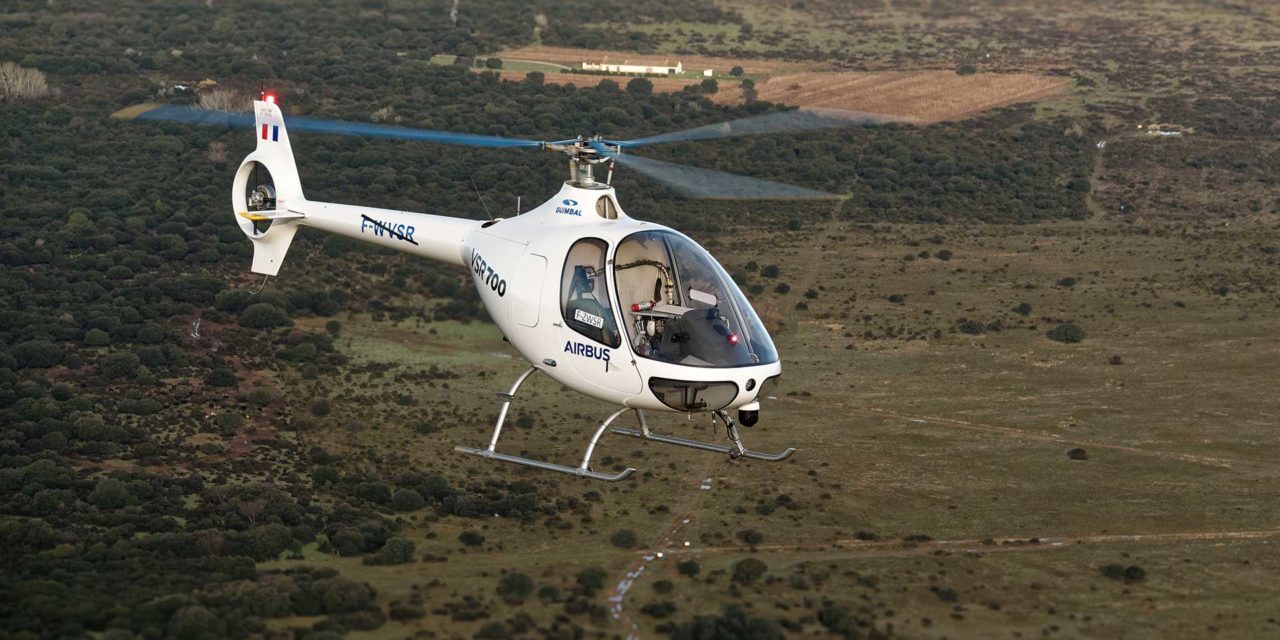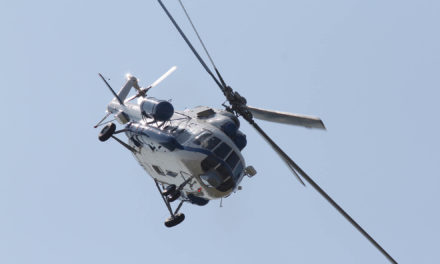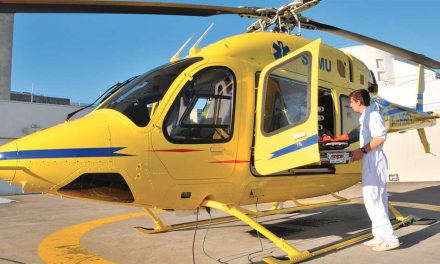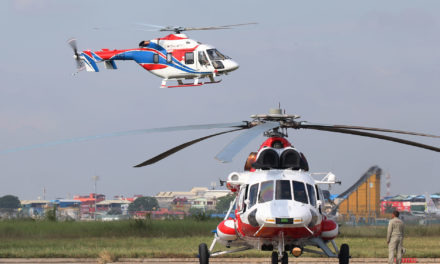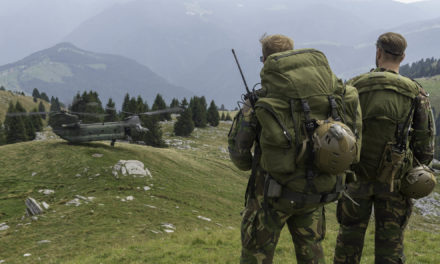The OPV (Optionally Piloted Vehicle) version of the two-seat aircraft took to the air for the first time without a pilot on board. The development of the VSR700, a rotary wing drone, is the result of cooperation between Airbus Helicopters and Hélicoptères Guimbal Helicopters.
Since May 2017, the demonstration model of the VSR700 (a Hélicoptères Guimbal Cabri G2 by Guimbal Helicopters dronized and transformed into an OPV), has made several autonomous flights. A safety pilot was however present on board only to meet the safety requirements, but without direct intervention on the flight.
On December 20th, 2018 a new step was taken with, this time, a first autonomous flight without a pilot on board. The flight, organized from the Istres air base in the south of France, lasted about thirty minutes. It covered a navigation course before coming back to land at its starting point. The aircraft was under the control and surveillance of a ground control station located on the base. An objective of this first flight was to demonstrate the compliance of the aircraft with the regulatory and safety requirements for drone flights in France.
Safety First
“With this aircraft, we first demonstrated our ability to integrate an autopilot, a vehicle management system and the entire flight chain at Cabri G2,” explains Airbus Helicopters. Beyond that, we have been able to prove the very high level of security achieved in the context of an autonomous flight, very close to that of the requirements of a certification, in order to obtain the go-ahead from the authorities to use the aircraft near a busy road and inhabited areas. This experience also allowed us to progress in understanding the process of certification of our aircraft with the DGA (Directorate General for Armament). This is a major step in this program that finally demonstrates the ability of Airbus Helicopters to fly a 700 kg helicopter in complete autonomy and safety.”
The next stage of the VSR700 program will be the first flight of the prototype, expected before the end of 2019. The model of the rotary wing drone was presented at the last Paris-Le Bourget Air Show and it showed a mainframe significantly reduced at the front of the aircraft compared to the Cabri G2, which an absence of passengers requires. Replacing the canopy, the aircraft receives a carefully sealed cowling to protect the avionics bay, the brain of the aircraft. If it gains a slightly more aerodynamic profile, the aircraft remains easily recognizable by its fenestron. The skids have also been reinforced to cope with shocks to the deck and the ground clearance has been increased to accommodate payloads under the fuselage barge.
Severe Constraints
“Dronize” and boarding a light helicopter on a ship is a seductive but terribly complex idea to carry out, which makes the VSR700 a particularly ambitious project. Other manufacturers have already struggled with this subject (see insert). Hélicoptères Guimbal and Airbus Helicopters initiated the VSR700 project about fifteen years ago. However, the market was not yet ripe and development was only really launched a year ago. The VSR700 will provide medium-sized ships with a remote radar and display unit, capable of seeing far out to sea, well beyond the usual radar horizon (about 100 nautical miles away). The work of radar picket, which consists of making circles in the sky at an economic speed of about 80 kt for hours is thankless and corresponds better to the use of a drone than that of a medium tonnage helicopter with a crew of three or four. A total autonomy of about twelve hours is expected for the VSR700, or eight hours of “playtime” in a station. A tank of approximately 220 kg or 250 liters of fuel will be installed at its center of gravity.
“The DGA can find several advantages to call on us” explains Bruno Guimbal, CEO of Guimbal Helicopters. “The Cabri is a proven helicopter, whose development is complete and paid for. The operating fleet is expanding every day and we have a constant flow of information to improve our equipment, to mature it and to ensure its navigability. We also maintain a solid base of suppliers and subcontractors, which is one of the most critical conditions for a military or parapublic program, which is by nature irregular”.
Technically, the Cabri stands out with its rotor, the great work of Bruno Guimbal and the keystone of the aircraft’s behavior. With a three-dimensional formula, it offers the desired maneuverability, with a low vibration level for embedded systems. The Fenestron also provides additional security. All those who know the Cabri are very confident about its ability to dock.
Diesel advantage
The choice of the motorization is also an essential element of the VSR700 development. For sailors, the choice is quickly made: for safety reasons, there can be no question of using gasoline on board ships. Combining the use of kerosene and low consumption, the diesel engine is therefore essential for the embedded drone. The development and integration of a 2-liter turbocharged common-rail turbo diesel engine began almost two years ago and continues today “with very promising results” according to Bruno Guimbal.
The strong point of diesel for the drone is obviously its low consumption. If the engine is a little heavier than a gasoline or turbine one, its equilibrium balance point is significantly lower than for all other engines. In other words, after only thirty minutes of operation, the turbine and its consumed fuel mass exceed its diesel equivalent. For an autonomy of about twelve hours, things are clear: the overall weight gain is very far in favor of diesel. It should be noted that the Rolls Royce 250 R66 turbine weighs 80 kg and consumes about 70 kg per hour. A diesel of the same power will weigh 200kg, 2.5 times more so, but consume twice less: about 35 kg per hour. For twelve hours of use, the turbine + kerosene will weigh 80+ (70×12), or 920 Kg. The diesel will be satisfied with 200+ (35 x12), or 620 kg. One-third less. To obtain ten hours of autonomy on the Firescout 2 (a dronized Bell 407), the difference is even more considerable since it is necessary to carry more than two tons of fuel in the aircraft!
The other big part in the development of the VSR700 is the autopilot, the vehicle management system and the entire flight chain, all led by Airbus Helicopters. It involves replacing the pilot and the human sensors with automations that act on the vehicle, especially in emergency situations. The engine start and shutdown phases will also be managed autonomously by the aircraft. Remote control will not be direct but will be done by giving high level commands: GPS for point to reach, or followed by a specific point with the radar or the optronic ball.
A promising market
The French Navy should put into service by 2023 its ISF (Intermediate Size Frigate) on which it is already planned to ship a drone, alongside a traditional helicopter. An agreement was reached on the use of the VSR700 between Airbus Helicopters and Naval Group (former DCNS, the first French military shipyard) which develops these frigates and the DGA has clearly positioned itself in favor of the aircraft. The agreement between Airbus Helicopters and Naval Group further provides that all future military vessels may be equipped with a drone system. “It’s a very large market that is opening up to us. And it can open an even bigger market for helicopter drones with high endurance and carrying capacity, both in the parapublic or civil sectors” predicts Bruno Guimbal.
Insert:
The adventures of embedded drones.
In the 1950s, the Navy asked the company Gyrodyne to design a helicopter weighing a ton, radio controlled and able to drop an anti-submarine torpedo with a range of one hundred kilometers. It was then a question of protecting American ships with the ability to keep Soviet submarines at bay, out of range. The QH-50 DASH flew for the first time in 1962 and the US Navy ordered 746 of them! The aircraft was apparently simple and reliable, but the Navy encountered considerable remote control problems, in particular because of the interference of the guidance systems with other electronic equipment onboard the ships. No less than 411 DASH were lost in flight! The last aircraft were removed from service in 1970. The next test was with Boeing’s Eagle Eye drone: a V-22 model with rotors and tilting propellers. The aircraft flew for the first time in 1998 but the only users were ultimately the US Coast Guard who eventually gave up the aircraft in 2006 after the loss of an aircraft. At the same time, the RQ-6 Outrider program was also canceled in the face of cost inflation and development difficulties. The MQ-8B Fire Scout, a one-ton unit on a Schweizer S333 base, equipped with a Rolls Royce turbine, is on the other hand a much more intense program, with today 28 aircraft in service. The aircraft can carry a wide range of sensors and armaments. The Pentagon is now investing in an even more ambitious device, the MQ-8C or Fire Scout 2, on a draconian Bell 407 basis. But with an aircraft of 1.6 tons of empty weight and two tons of fuel on board, the range will be no better than that of the 700 kg VSR700 load, with ten times less fuel.

